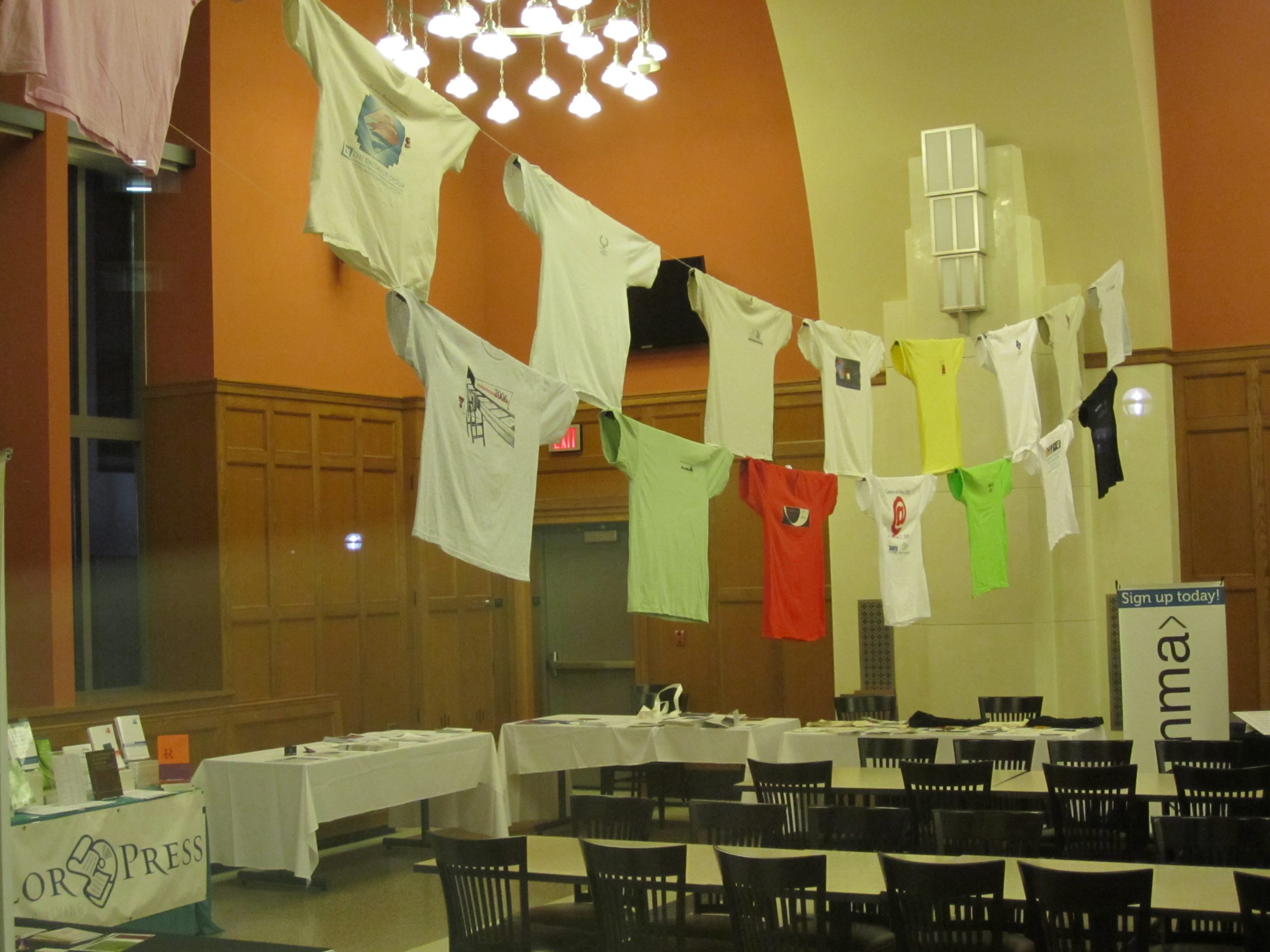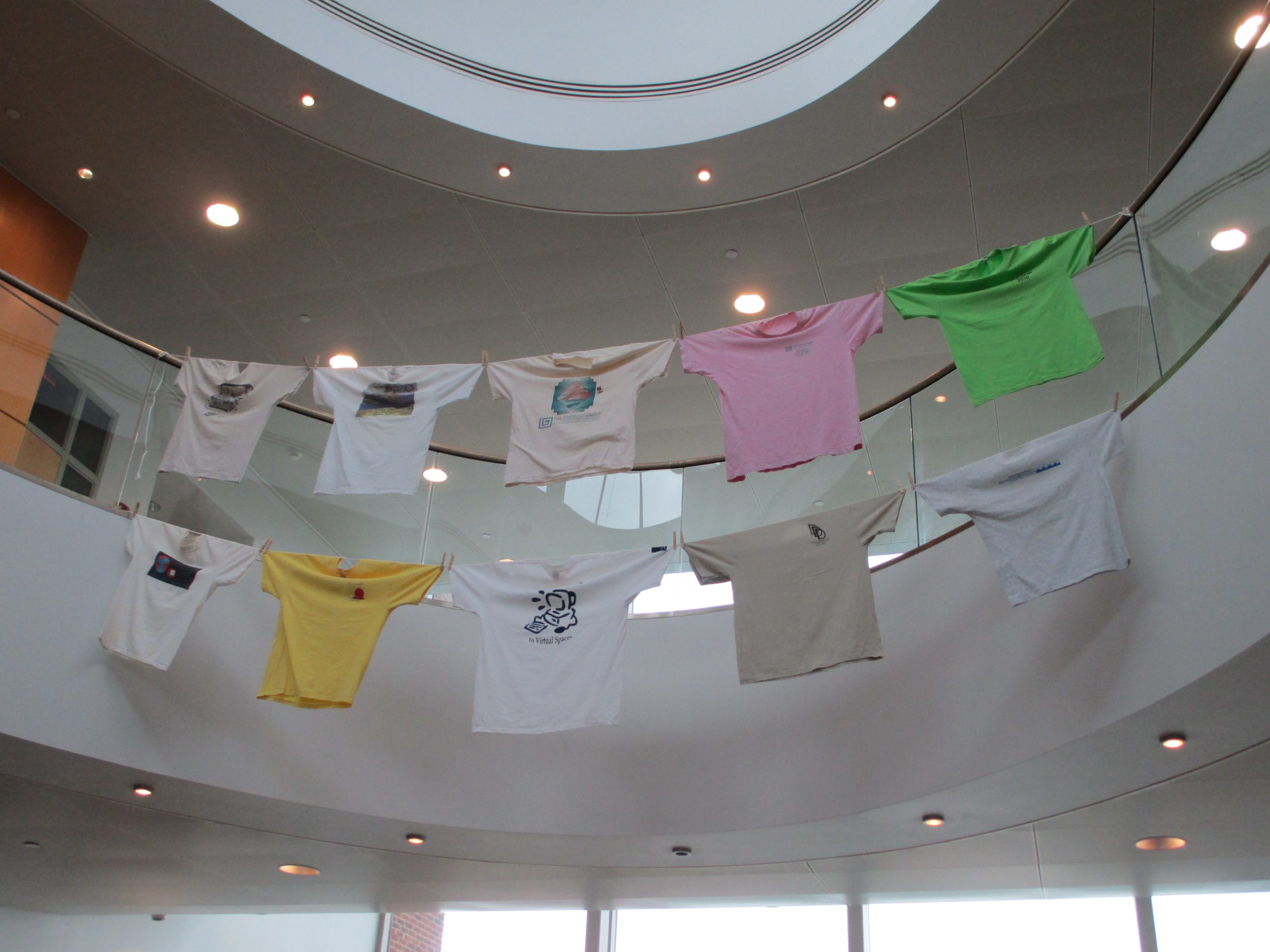- What were early digital rhetoricians thinking about more than two decades ago?
- What did they present on, and what topics were trending, not only in yearly conferences, but also in online discussions?
- Who were the major figures, and what were the projects they were working on?
These are some of the questions I wanted to begin to answer when I started the Computers and Writing Memorabilia Project (CWMP) in 2012.
However, to put the project in better context, I need to explain one thing. I am a pack rat. I save everything, including bottle caps, coins, and stamps. Thus it was that in 1991, when I began attending the Computers and Writing Conference (CWC), I naturally held on to physical artifacts such as programs, buttons, and later, the tee shirts that became ubiquitous at the conference. And I don’t let go of virtual objects easily, either. I have dozens of 3.5 inch floppy disks with archives of online CWC conversations, including highlights of early Megabyte University, Alliance for Computers and Writing, and TechRhet discussions. In 2000, when one of the first virtual synchronous textual communication environments for CWC scholars, MediaMOO needed a new home, I provided it, and it still runs as a sort of MOOseum on an ancient Dell under the desk in my office.
By about 2004, the year of the Honolulu CWC, I had accumulated enough artifacts to bring them to the conference and display them. That year, with the cooperation of the conference organizers, I hung the tee shirts around the perimeter of the registration area. In succeeding years, I brought the shirts and began displaying programs and other memorabilia from early conferences. Some conference organizers even had graphic designers plan and hang the display, and they provided display cases for programs and other artifacts.





At one conference, a few decades-old conference programs disappeared, and I had to rely on the collective good will of the community to replace them. But when I asked for contributions from fellow hoarders online, I realized that there were artifacts out there that I didn’t have, and that the best way to provide access to our history would be to put out a call for all available artifacts and to digitize them in a safe, tagable, editable, mine-able space online.
Thus was born the CWMP. In the first year, my university allowed me to have an advanced graduate assistant work to digitize the collection I hold, as well as to archive and tag contributions from across the country. I thank John Benson for his work in this regard; much of what you see at the CWMP site is a result of his work, with the support of Doug Eyman and the CCCC Committee on Computers in Composition and Communication and Eric Crump, Chief Cook, Bottle Washer, and Listmom at Interversity, which hosts the Computers and Writing site. All the programs and most of the other texts on the site are searchable on this Omeka site, so that interesting search queries and data mining are now possible.
Choosing what we archive and how we archive it is our way of speaking to the future. That is, if the tools for mining texts and artifacts, and for visualizing data keep getting more powerful and easier to use, researchers will probably want a searchable database that collects the artifacts we feel best represent our practices, our questions, our philosophies – in short, the arc of our discipline. We need resources like the CWMP not only to understand the past of our discipline, but also to help predict and shape where we are going.
Since I have only had an assistant for one semester, much of the site is unfinished. Thus, we have a pressing need for volunteers to put out calls for artifacts, and then to digitize, upload, and tag what comes in. Until we can upload more of the texts and images, and hopefully even videos and sound clips, we have only a partial archive of the rich history of the CWC. If the project is to continue, we need people to help with the day-to-day activities: planning the shape of the collection, collecting and digitizing, and tagging. We also need people to explore and learn how to use the growing number of open-source tools for data-mining and visualization, with an eye toward projects such as:
- A study of the visual rhetoric of CWC program covers, signage, and tee shirt designs
- A digital concordance and trend analysis of words that appear in conference programs over time
- A tagged, searchable collection of videotaped recollections of key events in CWC history
- A set of metadata about the conference: who attended? Who presented?
- Conference organizers’ memories and photographs
- A geographical visualization of conference sites, emphases, and numbers of attendees
- Linking to, indexing, and archiving CWC Online discussion sites such as MediaMOO
- Keyword/semantic analysis of synchronous and asynchronous conference discussion
If you are interested in the CWMP and would like to get involved, or better yet, if you have a class that would like to get some experience in building, tagging, cataloging, mining, and/or visualizing a discipline-specific database, please contact me at mday@niu.edu.

1 Comment
Very cool stuff! Let’s work to get your site connected to the memorabilia site.